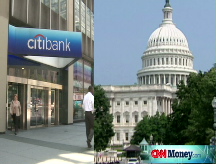Treasury unveils 'stress test' for banks
Regulators will push lenders to examine their ability to absorb losses in the event unemployment climbs above 10% and home prices fall another 20%.
NEW YORK (CNNMoney.com) -- The Obama administration unveiled plans Wednesday aimed at assessing the health of the nation's 19 largest banks in order to determine the size and scope of future bailouts.
Under the so-called "stress test" program, which was first hinted at earlier this month when the White House rolled out its financial recovery plan, banking regulators would examine major financial institutions like Citigroup (C, Fortune 500), Bank of America (BAC, Fortune 500) and JPMorgan Chase (JPM, Fortune 500), estimating firmwide losses for the next two years if economic conditions worsened and the bank's ability to absorb such losses.
Industry regulators, including the Office of Thrift Supervision and the FDIC, are expected to look at the performance of different assets owned by banks, including loans and such exotic securities as collateralized debt obligations, under two different scenarios.
One would rely on current consensus economic expectations, while the other would focus on a "more adverse" scenario in which unemployment climbs above 10% and home prices decline another 20% over the next two years.
Senior government officials said that those tests would help regulators identify which banks may require additional government support and how much.
If regulators deem that a bank needs additional funds, the company will be given six months to secure aid from private investors.
If those efforts fail, the government would step in and buy convertible preferred shares. Over time, it is expected that the bank would convert those holdings into common stock, helping to boost a key measure of capital adequacy.
Officials said they would not make public the names of those banks that require additional assistance, although institutions may be forced to show their hand at some point, especially if they are trying to raise funds in public markets.
Nevertheless, officials stressed that money would be there for the banks that need it, even as Treasury's budget for spending on financial institutions may appear stretched thin.
"One clear certainty is that capital will be there," said one official.
In some sense, regulators may be hoping that the new tests will also help the government more carefully target the remaining funds from the second half of the $700 billion bailout program.
"It was ready, aim, fire on the first one," said Donald Musso, president and founder at the New Jersey-based financial services consulting firm FinPro. "Now there is a little more precision in the decision making."
One key provision of the stress test program, however, is that banks accepting further funds would be required to increase lending. Many banks that received taxpayer funds under the original Troubled Asset Relief Program, or TARP, which was unveiled late last year, were criticized for hoarding cash.
After the Treasury Department started making its first round of capital injections last October, those banks that accepted government funds faced heavy criticism from lawmakers and taxpayers for failing to use the funds to make new loans.
Fanning that anger was an unwillingness by many institutions to make any changes to their seemingly lavish spending habits.
Regulators said they hope to complete their examinations as quickly as possible, but all determinations would be made no later than the end of April.
Shares of most financial firms including Bank of America, rallied on the news, climbing 9%. Other large banks were also higher after treading in negative territory for most of the session, including JPMorgan Chase and Wells Fargo (WFC, Fortune 500), which gained 3% each. Bucking the trend was Citigroup, which ended the session 3% lower.
Many big bank stocks have managed to eke out gains this week as top administration officials downplayed fears that the government may have to step in and take control of the country's largest financial institutions. ![]()


